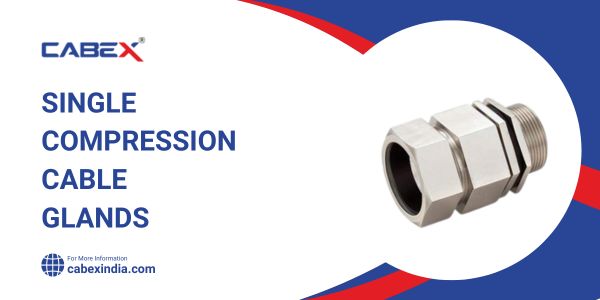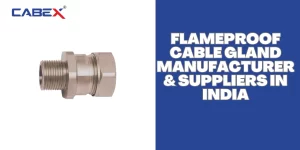Introduction
In the labyrinth of modern industries, where the seamless flow of information and power is paramount, cable management emerges as a silent hero. The unassuming yet indispensable cable glands play a pivotal role in orchestrating this organized chaos. These small devices, often overlooked, serve as the guardians of cable integrity, ensuring that vital connections remain untangled and protected. In this exploration, we unravel the significance of cable management, the role of cable glands, and why single compression cable glands are the future of efficient cable organization.
Advantages of Single Compression Cable Glands
Diving beneath the surface, we discover a realm of advantages that single compression cable glands bring to the table:
Enhanced Seal and Protection
Imagine a world where cables are shielded from the relentless forces of dust, moisture, and the unpredictable outdoors. Single compression cable glands are the sentinels of such a realm. Their impermeable seal stands as a bulwark against environmental adversaries, ensuring cables remain unscathed and operational even in the harshest conditions. From sprawling construction sites to remote weather stations, this protection is indispensable.
Efficiency Redefined: Time and Cost Savings
The intricate dance of cable installation often involves a multitude of steps and components. Enter single compression cable glands, streamlining this intricate ballet into a harmonious single step. The result? A symphony of time and cost efficiency. Industries, from sprawling factories to ambitious construction projects, reap the rewards of reduced labor hours and streamlined processes, translating to substantial savings.
Enquiry Now!
About Single Compression Cable Glands
Unraveling the Enigma: Reduced Risk of Cable Damage
The vulnerability of delicate cables during installation is an age-old challenge. Single compression cable glands provide the answer, elegantly unraveling this enigma. Their single-step compression process gently embraces the cable, preventing distortion and damage. Delicate fiber optics and sensitive data cables find a safe haven, ensuring uninterrupted functionality in a world where connectivity is king.
Versatility Beyond Measure: A Multifaceted Range of Applications
The versatility of single compression cable glands is a testimony to their ingenuity. Witness their indomitable presence across a spectrum of industries:
Industrial Fortitude
In the heart of industrial automation, where the rhythm of machines dictates productivity, single compression cable glands stand as stalwart guardians. They shield cables from the relentless march of machinery, ensuring uninterrupted operations.
Construction and Safety
The monumental task of construction demands precision and safety. Single compression cable glands ensure these twin goals are met, organizing cables with finesse and preventing potential hazards.
Renewable Resilience
Amid the winds of change in renewable energy, single compression cable glands hold the fort. They stand guard in solar farms and wind energy systems, shielding power cables from the elements and ensuring energy generation endures.
Telecommunication Triumph
In the world of high-speed communication, signal integrity reigns supreme. Single compression cable glands ensure this integrity, guarding against disruptions and enabling seamless data transmission.
Installing Single Compression Cable Glands: A Step-by-Step Guide
Delve into the meticulous process of installing single compression cable glands:
Preparation and Cable Preparation
- Demystify the process of selecting the perfect gland size based on cable specifications.
- Provide a detailed step-by-step guide to meticulously strip and clean cables, ensuring optimal installation conditions.
Insertion and Compression
- Break down the process of inserting cables into the gland, emphasizing accuracy and precision.
- Unveil the mechanics of the single-step compression process, highlighting its pivotal role in securing cables.
Tightening and Testing
- Elaborate on the importance of securing the gland with precision, ensuring a snug fit.
- Guide readers through the essential seal test, underlining its significance in validating the effectiveness of the installation.
Key Considerations for Successful Usage
Navigate the key considerations that pave the way for successful utilization of single compression cable glands:
Temperature Resistance
- Uncover the impact of temperature variations on cable glands and elucidate the necessity of resistance.
- Highlight scenarios where temperature resistance plays a critical role, underscoring its importance.
Cable Compatibility
- Decode the science behind matching gland specifications with cable types, averting compatibility issues.
- Showcase the dire consequences of overlooking compatibility, driving home the importance of this consideration.
Environmental Conditions
- Delve into the nuanced effects of environmental factors on cable glands, providing insights into their vulnerability.
- Paint a vivid picture of industries where these conditions are a constant challenge, reinforcing the need for resilience.
Certifications and Standards
- Emphasize the weight of industry standards and certifications, shedding light on their role in ensuring quality and reliability.
- Present a comprehensive list of common certifications readers should seek when selecting cable glands.
Conclusion
The landscape of cable management is transformed by the innovation of single compression cable glands. Through a journey that unfurls the tapestry of their advantages, applications, installation, and considerations, their significance becomes undeniable. They represent the bridge between chaos and order, safeguarding connections that power our industries. As you embark on your cable management journey, let the light of single compression cable glands guide you towards efficiency, protection, and the seamless flow of communication and power. Consider these unsung heroes as you pave the way for a connected and organized future.
FAQ:
How do Single Compression Cable Glands work?
Single Compression Cable Glands work by creating a tight seal around the cable as it passes through an opening in an equipment enclosure. The cable is inserted through the sealing gland, which is designed to accommodate various cable diameters. Once the cable is in place, the compression nut is tightened onto the threaded body, compressing the sealing element against the cable and the enclosure wall.
What are the advantages of using Single Compression Cable Glands?
Single Compression Cable Glands offer several advantages:
Environmental Protection: They provide effective sealing against moisture, dirt, and other contaminants, ensuring the longevity and reliability of equipment.
Ease of Installation: These cable glands are relatively easy to install, requiring only basic tools. They are suitable for a wide range of cable sizes and types.
Vibration Resistance: The compression nut design ensures a secure connection that can withstand mechanical vibrations, making them suitable for industrial and outdoor applications.
Versatility: Single Compression Cable Glands can be used in various industries, including telecommunications, manufacturing, renewable energy, and more.
What are some considerations for choosing the right Single Compression Cable Gland?
When selecting Single Compression Cable Glands, consider the following factors:
Cable Diameter: Ensure the gland can accommodate the diameter of the cable being used.
Material: Choose a material that suits the application environment, such as stainless steel for corrosive environments or nylon for general use.
IP Rating: Check the Ingress Protection (IP) rating of the gland to determine its level of protection against dust and water.
Temperature Range: Ensure the chosen gland can withstand the temperature range of the application location.
Certifications: Depending on the industry, certifications such as ATEX or UL might be necessary for hazardous locations or compliance with safety standards.






